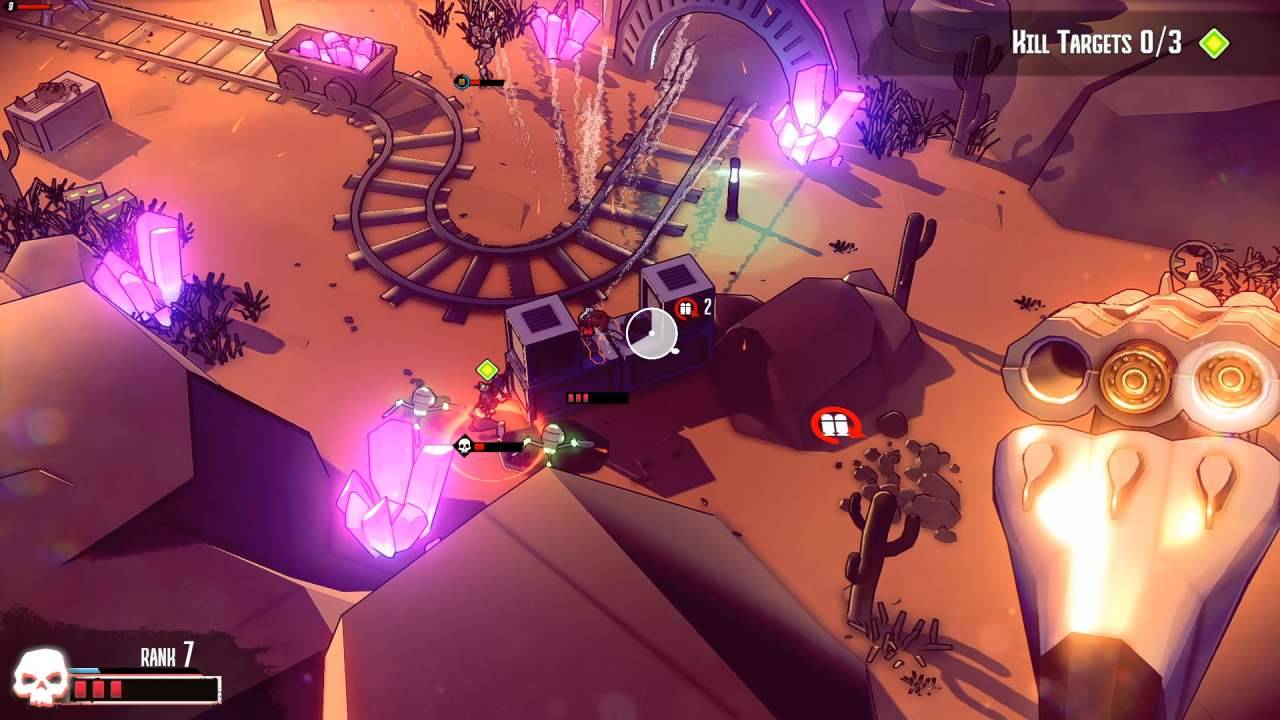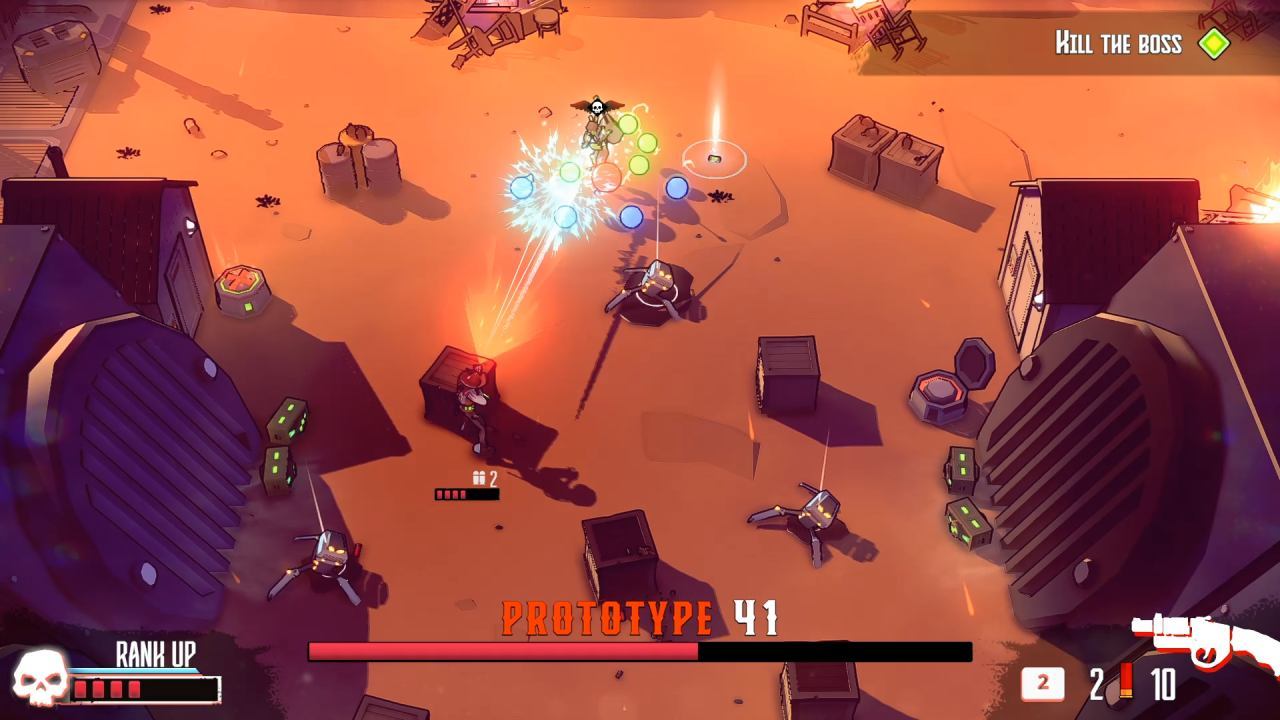Dust & Neon Review
PC
A fun and satisfying twin-stick shooter and roguelite that doesn’t ultimately do anything new, but it should keep you entertained for a while.
Reviewed by LCLupus on Feb 27, 2023
Dust & Neon is the first game by David Marquardt Studios, and it is a roguelite twin-stick shooter with a combination of a sci-fi and Western aesthetic. It looks pretty great and playing as a robot cowboy as he slings his way through one duel after another with scores of enemy robot cowboys is a great way to spend a few hours. The game could be said to have the mildest of stories, but it’s generally entirely gameplay-oriented from start to finish as you complete one mission after another.
Dust & Neon has satisfying combat. That is an integral aspect of the game, and it’s something that the game pulls off well. The general gameplay involves you, as your cowboy robot, making your way through each semi-open level with multiple routes through it while blasting away at your enemies. You do this by generally taking cover more so than dodging. Many of these kinds of games tend to become bullet-hell experiences as you dodge around the screen, but Dust & Neon is more of a cover shooter than many of those games tend to be.

Your little robot automatically takes cover whenever you get near a piece of cover, and enemies will often do the same. So, it’s up to you to pop out of cover and take them out while they are out of cover or while they attempt to flank you. In addition, reloading is an integral aspect of Dust & Neon. Whenever you reload, there’s a special animation that shows the reloading of the weapon on the screen, and you have to hit the reload button as many times as the weapon has chambers. This means that every gun in Dust & Neon is essentially a revolver of some sort.
The importance of reloading is not dedicated to the player character alone though, as enemies also need to reload. This is generally when it’s considered best to strike. Or you can go in with a more guns-blazing attitude and take them out from behind the cover, but if you want to play it safer, you can just play the cover game. However, many enemies will attempt to flank you or run up to you, especially the melee-only enemies who will rush straight up to you. So, it becomes imperative to learn your way around the different types of enemies whenever you enter a combat situation.
When it comes to what you do in each level aside from shooting people, well, you explore. Exploration is important for finding ammo, health, cash, special currency, and new guns. New guns are especially important because you want to be constantly upgrading your arsenal. These guns are found on a randomized system because Dust & Neon is, as previously mentioned, a roguelike. It is a roguelite in more ways than only the exploration. It is also a roguelite in the way you choose your missions.

The missions are given to you on a randomized screen in which new missions can constantly crop up that can be tackled in whatever order you want. Those missions have a variety of possible objectives within them. You could be told to kill a certain number of a certain kind of targets, you could be tasked with destroying a specific object, or you could just be told to kill every enemy in a level. It varies but not to any extraordinary degree. There are also, of course, boss fights.
Boss fights unlock after you reach a certain experience level. However, boss fights are a bit different to the rest of the game. In Dust & Neon, bosses are a lot more complex than every other enemy and they typically involve some kind of unique strategy as you figure out how best to stay alive long enough to kill them. For instance, the very first boss shoots waves of slow-moving projectiles at you and he also has a shield comprised of that same kind of projectile. You need to get through that shield to harm him, and whenever you do, you need to start a new phase of the fight. This means that the boss encounters are kind of like puzzle encounters too, and once you figure out how to do them, they become about endurance.
Another aspect of Dust & Neon that is extremely roguelite in nature is that you can die repeatedly. There is some level of progression attached to dying as it brings you back to the hub world where you re-select your weapons. Dying is an opportunity to learn from past mistakes and try again. You are not penalized too heavily for your deaths, so it’s kind of like a Dark Souls game in that respect. However, you are penalized more in a Dark Souls game than you are in Dust & Neon.

Your hub world is a place where you can upgrade various aspects of your character. You can upgrade the special gun randomizer that gives you your starting weapons, you can get discounts from the gun shop, or improve the temporary upgrade items you can purchase from various vendors in the hub world. These upgrades are all made using the special currency you can find throughout each mission. The hub world is your little safe space where you can prepare for your next run, and it is also the place where you can upgrade your character.
Your robot cowboy in Dust & Neon is a gunslinger, but he has two main branches of personal upgrades based on experience points. These two branches are offensive and defensive branches. So, do you want more health or the ability to roll more, or do you want higher damage and a higher carrying capacity for shotgun shells? This depends on the kind of player you happen to be, and it’s a basic upgrade system with little overall deviation. This also means that Dust & Neon is not a game where you can build your own kind of character, you’ll just become a stronger version of the one you started with.
Dust & Neon is not a story-based game, but there is technically a story there. You’ll likely be far more focused on the various robots you need to shoot though, and that heavy focus on constant shooting does lead to a bit of a technical issue. In fact, it leads to two rather big technical issues. The first is that there are sometimes hitbox problems. You’ll shoot at an enemy and be certain that you hit them, but no damage is registered. This is especially prevalent when it comes to enemies that are very close to you. You’ll fire away and nothing will seem to happen. This isn’t great.
The second technical issue is simply one concerning clip size. Practically every weapon has a remarkably small clip size. You are constantly reloading, and unlike the reloading in something like BPM: Bullets Per Minute, the complex reloading does not feel like it’s a cool part of gameplay but rather a contrivance for stylistic purposes. You’ll be reloading so often, and some weapons can have clips as tiny as two to three bullets per reload. So, you shoot two to three times and then have to reload by hitting the reload button two to three times to fully reload your weapon. Rinse and repeat.
Dust & Neon is definitely going for something, and it does include a very satisfying overall gameplay loop, but the technical issues can be grating in the long term as they are persistent, and once you become accustomed to the way things are done in the game, there’s no real deviation. The game becomes one experience that becomes saturated over time. It’s fun in bursts and it should keep you entertained for a while if it’s the kind of game you enjoy, but it doesn’t do anything particularly new with the formula.
Contributor, NoobFeed
Verdict
Dust & Neon is definitely going for something, and it does include a very satisfying overall gameplay loop, but the technical issues can be grating in the long term as they are persistent.
75
Related News
No Data.

